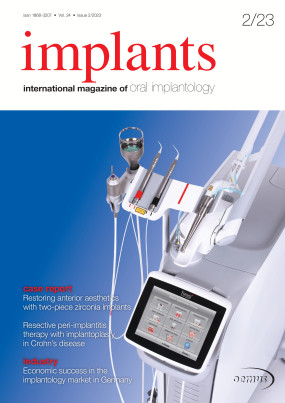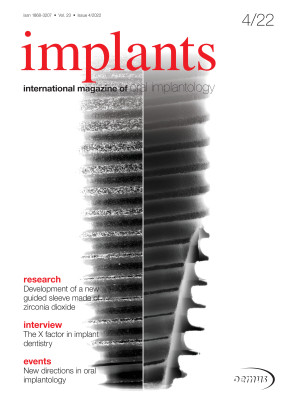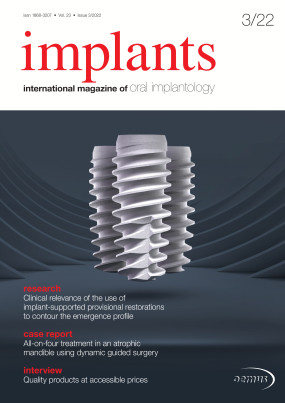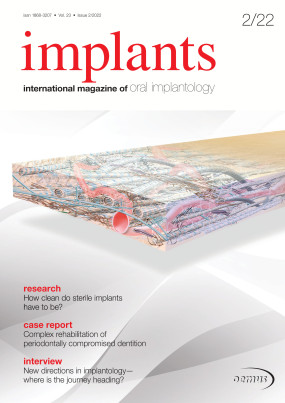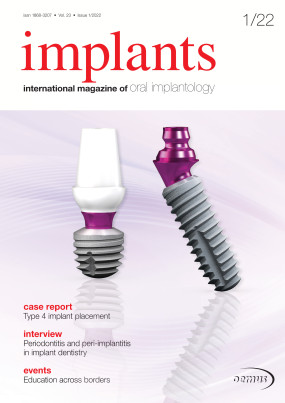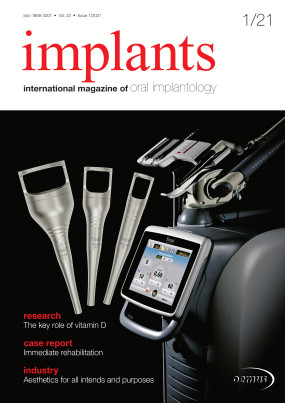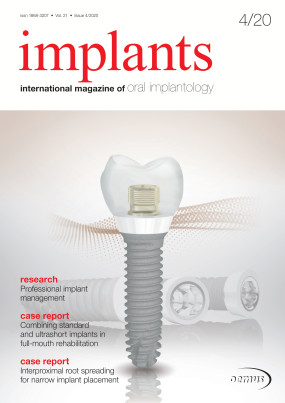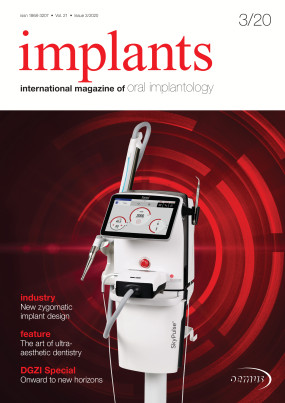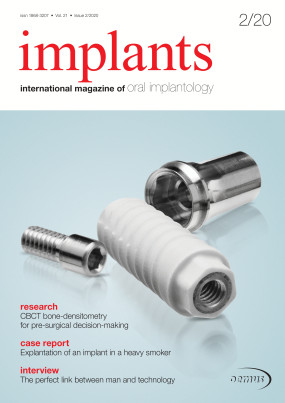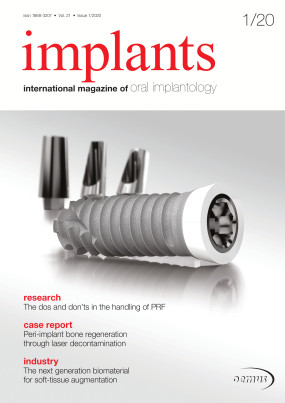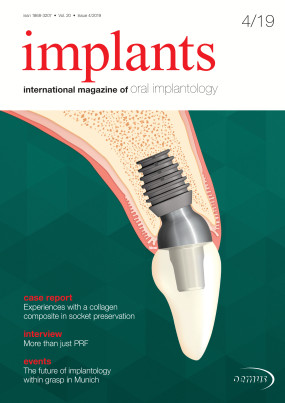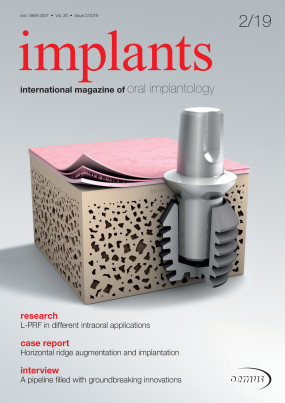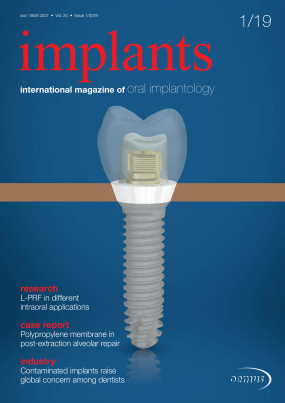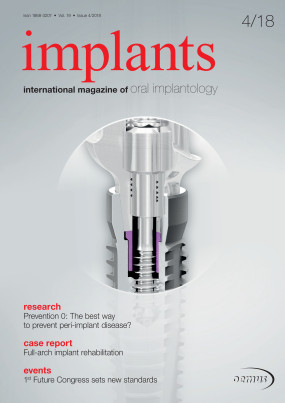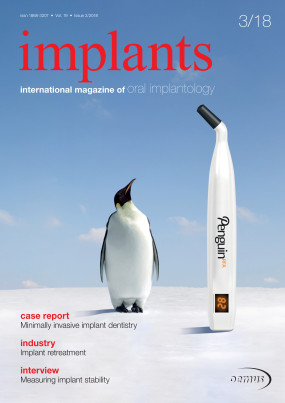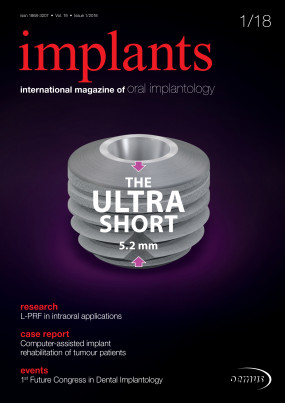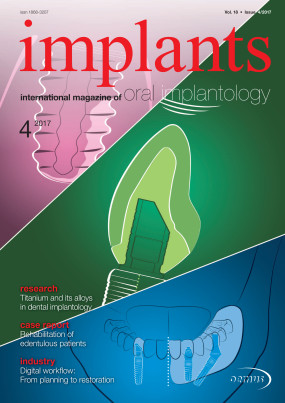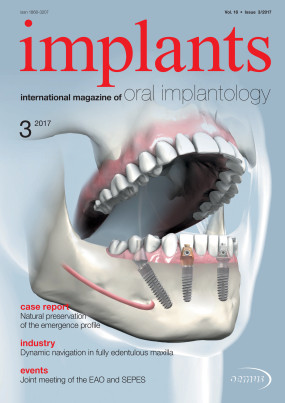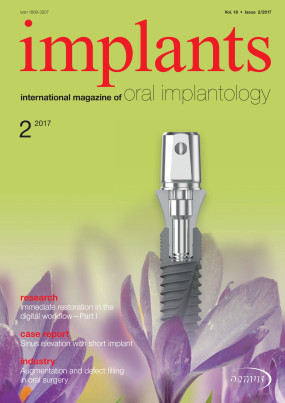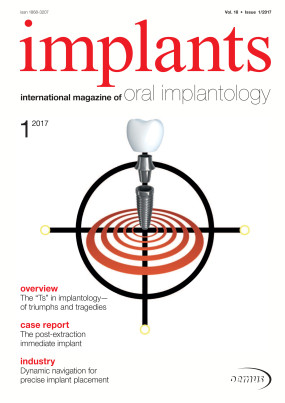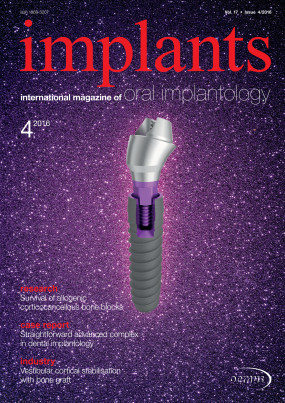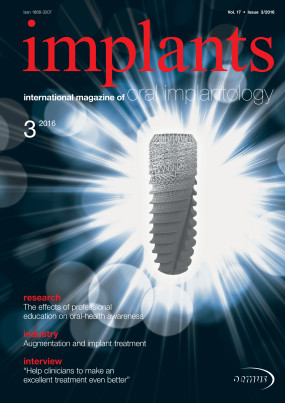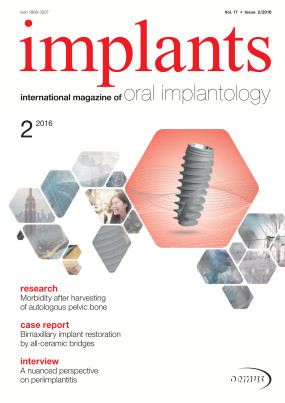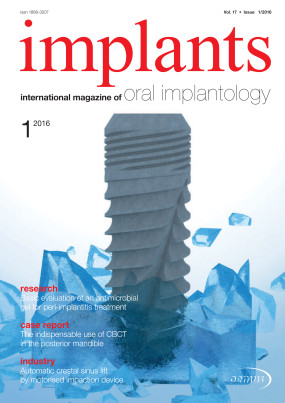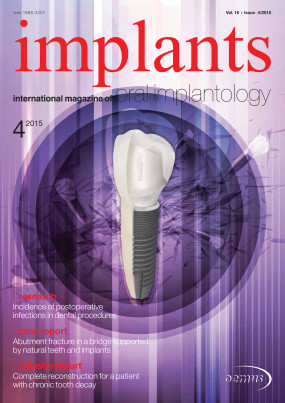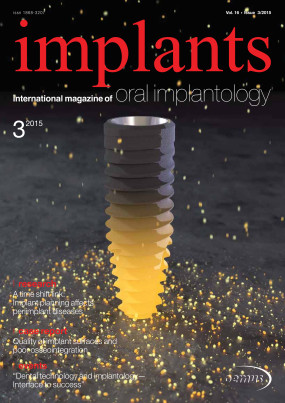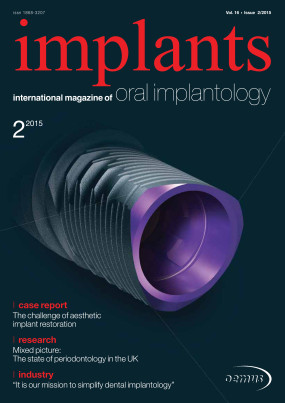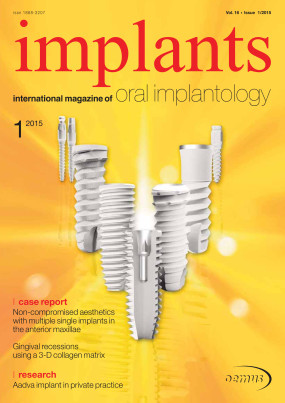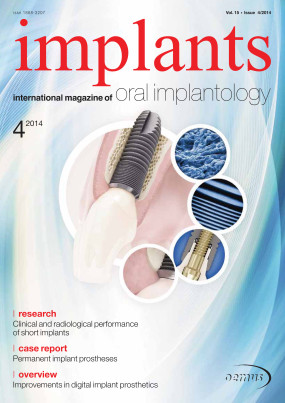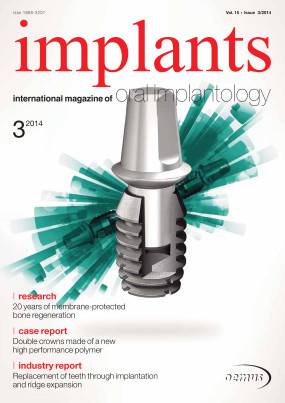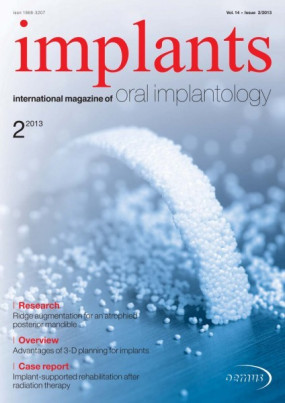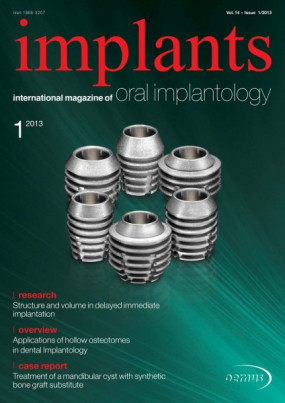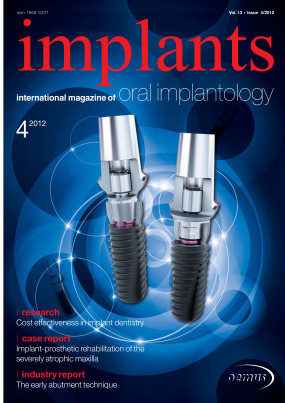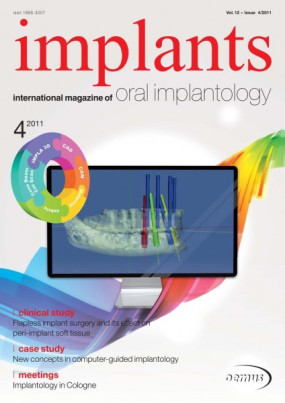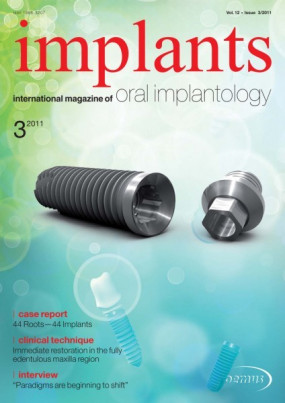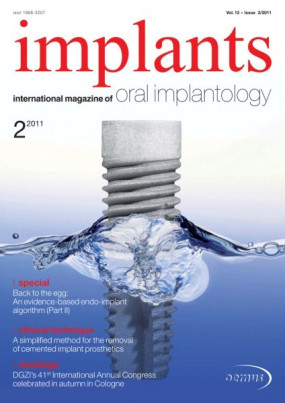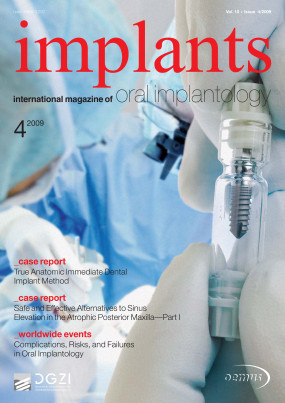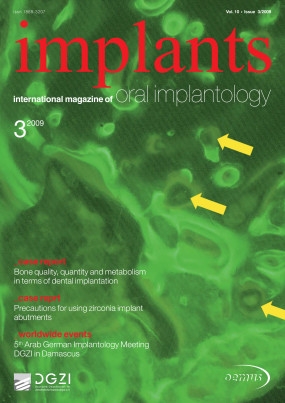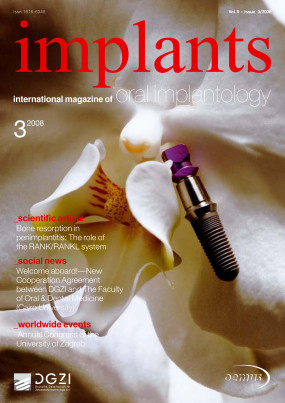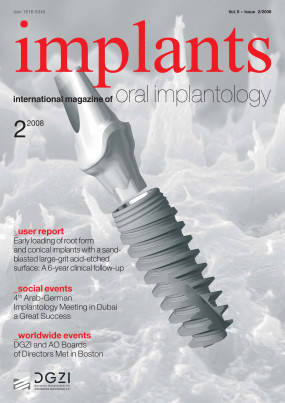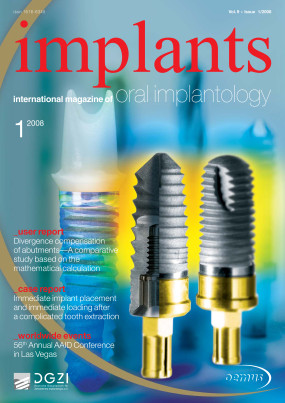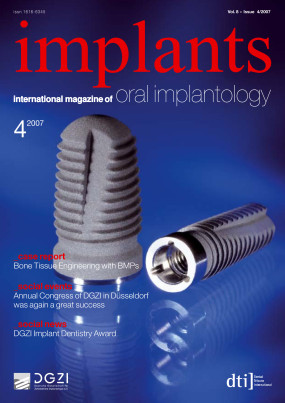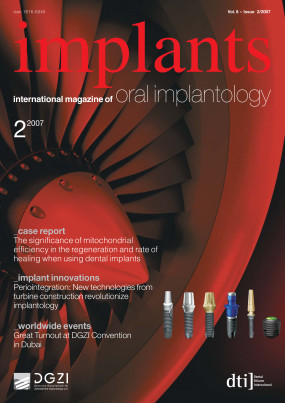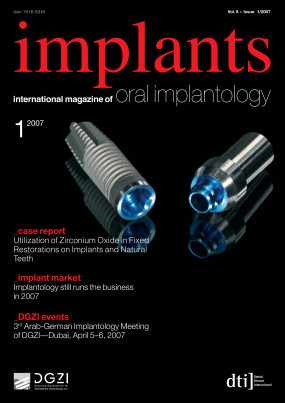Inhaltsverzeichnis
3
I think I can honestly say that we made history early in October at DGZI’s 40th International Annual Congress in Berlin. Like no other implantological association, DGZI represents the extraordinarily successful development of implantology from an “unorthodox” treatment, faced with many opponents and supported by only a few enthusiasts, to a modern, renowned and scientifically-documented dental discipline...
6
Single molar restoration - Wide implant versus two conventional
Prof Dr Amr Abdel Azim, Dr Amani Zaki, Dr Mohamed el Anwar, Egypt
The single-tooth restoration has become one of the most widely used procedures in implant dentistry.1 In the posterior region of the oral cavity, bone volume and density are often compromised. Occlusal forces are greater in this region and, with or without parafunctional habits, can easily compromise the stability of the restorations (Fig. 1). 2, 3...
12
Implant fracture: A look at the physical mechanisms for failure
Dr Dov M. Almog, Dr Odalys Hector, Dr Samuel Melcer, Dr Kenneth Cheng, USA
The etiology and physical mechanism of fractured dental implants phenomenon have been reviewed and studied at length in recent years.1–8 For the most part, the studies concluded that the crown-to-root ratio guidelines associated with natural teeth should not be applied to a crown-to-implant restorations ratio. According to these studies, the crown-to-implant ratios of those implants that were considered successful at the time the reviews took place were similar to those implants that failed. Apparently, according to some of these studies, the guidelines that are used by some clinicians to establish the future prognosis of implant supported restorations are usually empirical and lack scientific validation as far as the possible causes for implant fractures. However, as oral implantology has been the fastest growing segment in dentistry, the gaining of insight into these failure processes, including the accurate understanding of critical anatomical, restorative and mechanical information, might stimulate the clinicians’ implementation of preventive action that may avoid the future fractures outcome with dental implants...
14
In vitro wear of human enamel opposing ytzp zirconia - And various polished dental porcelain surfaces
T. R. Tambra, M. E. Razzoog, B. R. Lang, R. F. Wang, B. E. Lang, UK
Porcelain fused to metal restorations are the most widely used restorations in dentistry today. However, in some clinical situations a lack of inter-occlusal space does not allow for the appropriate thickness of opaque and dentine porcelains to be applied to the metal substructure. Consequently, the opaque layer may still be visible and imparts a matt, lifeless appearance to the final restoration. The dentist should also consider the effect the restorative surface will have on opposing enamel. The hardness of a ceramic material has been viewed as a predictor of its potential to abrade human enamel, and thus manufacturers have been pushed to develop ceramics with equivalent hardness to enamel to try and solve the wear issue.1, 2 However, the microstructural elements of a ceramic as well as fracture toughness and hardness all influence the wear characteristics of the material.3, 4, 5...
24
Owing to the loss of vertical bone volumes in the maxillary sinus area, an implantation with sufficient primary stability is often not possible. In many cases a therapeutical consequence is introduction of a bone augmentation in the sinus area (sinus lift). Fear of this procedure and higher costs are often the causes of why patients resist having this operation done. Because of these reasons, our development moved to the next step. With the Jeder®-System it is possible to perform a sinus lift without the use of a scalpel. In comparison to the conventional lateral fenestration of the buccal sinus bone, in our procedure all one needs is a small opening on the crestal alveolar ridge. Over this opening it is possible to place the augmentation material and the implant itself. The risk of a rupture in the Schneiderian membrane can also be reduced through this innovative technique...
28
3-D alveolar ridge reconstruction in a case with severe bone loss
Prof Dr Marcel Arthur Wainwright, Germany
A high clinical evidence of grafting procedures from extraoral autologeous donor sites like i.e. from the iliac crest in difficult bone loss sites is still the practice in oral or oral-maxillofacial surgery. However, the invasive surgery combined with a prevalence of patients morbidity and suffer is an issue to discuss the persisting legitimation of this procedure. Since the appearance of reliable bone substitute materials with or without any autologeous bone added, the positive results concerning longterm stability of regenerated bone even in difficult cases have become very predictable...
32
The use of polylactide--coated b-TCP - Closure of oroantral communications
Dr Stefan Neumeyer, Dr Stefanie Neumeyer-Wühr, Germany
Methods for the closure of oroantral communications that occur occasionally after tooth extraction are invasive and laborious. Here, we assessed a simple and efficient technique to close such perforations in nine patients. The oroantral communication at the bottom of the extraction socket was covered with oxygenized, degradable cellulose and the coronal two thirds of the socket were filled with in-situ hardening polylactide-coated b-tricalcium phosphate (b-TCP). An airtight, stable barrier could be established in all cases, and wound healing was uneventful. The novel procedure was minimally invasive and patient-friendly. Soft tissue covered the material after two weeks, and the biological width was reestablished after two months. Hard and soft tissue structures were preserved. The bone substitute has been partially replaced by alveolar bone at the end point of this case-cohort study. A complete regeneration of the alveolar bone can thus be expected...
38
After 40 years, DGZI is in its prime - DGZI celebrates its anniversary with a top class congress
Dr Christian Ehrensberger, Germany
DGZI (German Association of Dental Implantology) celebrated its 40th Annual International Congress on October 1st and 2nd in Berlin. With over 500 participants it attracted wide interest and met all ambitious expectations. Highly qualified speakers from practice and science gave an insight into the status of and future opportunities in this booming field of dentistry. Not only did we celebrate the anniversary of our association, but DGZI’s efforts in promoting the standing implantology in dentistry were also celebrated, as the success of this field is due in great deal to the efforts of DGZI...
42
Refreshing one’s knowledge and receiving updates at the same time—the clear structure of DGZI (German Association of Dental Implantology) “Anatomy” curriculum has made it a long-standing favourite. Including an insightful theoretical introduction, an impressive demonstration including a live video broadcast from the dissection room, and patient-side practice on human specimens, this weekend course (October 8 and 9 in Dresden) was once again a success. In addition, the number of international participants continues to rise—this year one quarter of the 40 participants came from abroad. A special pre-course-program started already on Thursday. Prof Dr Mazen Tamimi reported about the advantages of a modern navigation system. A hands-on-course and dinner sponsored by Schütz Impla Dental completed the program on Thursday...









